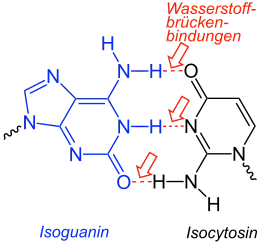Isoguanin
Isoguanin ist eine heterocyclische organische Verbindung mit einem Puringrundgerüst. Es ist ein Isomer der Nukleinbase Guanin, wobei Aminogruppe und Carbonylgruppe die Plätze tauschen. Es ist unter anderem Bestandteil des Nukleosids Isoguanosin.
| Strukturformel | |||||||||||||||||||
|---|---|---|---|---|---|---|---|---|---|---|---|---|---|---|---|---|---|---|---|
 | |||||||||||||||||||
| Allgemeines | |||||||||||||||||||
| Name | Isoguanin | ||||||||||||||||||
| Andere Namen |
| ||||||||||||||||||
| Summenformel | C5H5N5O | ||||||||||||||||||
| Kurzbeschreibung |
weißer bis gelblicher Feststoff[1] | ||||||||||||||||||
| Externe Identifikatoren/Datenbanken | |||||||||||||||||||
| |||||||||||||||||||
| Eigenschaften | |||||||||||||||||||
| Molare Masse | 151,13 g·mol−1 | ||||||||||||||||||
| Aggregatzustand |
fest[1] | ||||||||||||||||||
| Schmelzpunkt |
>300 °C[2] | ||||||||||||||||||
| Löslichkeit |
praktisch unlöslich in Wasser[3] | ||||||||||||||||||
| Sicherheitshinweise | |||||||||||||||||||
| |||||||||||||||||||
| Soweit möglich und gebräuchlich, werden SI-Einheiten verwendet. Wenn nicht anders vermerkt, gelten die angegebenen Daten bei Standardbedingungen. | |||||||||||||||||||
Vorkommen
Isoguanin kommt jedoch nachweislich in der Krotonbohne, in Schmetterlingsflügeln (Prioneris thestylis) und in einem Weichtier vor. Es wurde in RNA aus Mäuseleberproben sowie in menschlichem Urin und Liquor identifiziert und quantifiziert.[4]
Verwendung
Isoguanin wird zusammen mit Isocytosin zur Untersuchung von ungewöhnlichen Basenpaarungen in der DNA herangezogen.[5][6][7]

Einzelnachweise
- Eintrag zu Isoguanine, >98.0% bei TCI Europe, abgerufen am 15. Januar 2022.
- Eintrag zu Isoguanine bei Toronto Research Chemicals, abgerufen am 15. Januar 2022 (PDF).
- David R. Lide: CRC Handbook of Chemistry and Physics: A Ready-reference Book of Chemical and Physical Data. CRC Press, 1995, ISBN 978-0-8493-0595-5 (books.google.com).
- Allan Weimann, George McLeod, Trine Henriksen, Vanja Cejvanovic, Henrik E. Poulsen: Identification and quantification of isoguanosine in humans and mice. In: Scandinavian Journal of Clinical and Laboratory Investigation. Band 79, Nr. 4, 2019, ISSN 0036-5513, S. 225–232, doi:10.1080/00365513.2019.1585566, PMID 30888208.
- Andrzej Jaworski, Józef S. Kwiatkowski, Bogdan Lesyng: „Why isoguanine and isocytosine are not the components of the genetic code“, International Journal of Quantum Chemistry, Supplement: Proceedings of the International Symposium on Quantum Biology and Quantum Pharmacology, 1985, 28 (Supplement S12), S. 209–216 (doi:10.1002/qua.560280720).
- Christopher Roberts, Rajanikanth Bandaru, Christopher Switzer: „Theoretical and Experimental Study of Isoguanine and Isocytosine: Base Pairing in an Expanded Genetic System“, J. Am. Chem. Soc., 1997, 119 (20), S. 4640–4649 (doi:10.1021/ja970123s).
- Xiang-Lei Yang, Hiroshi Sugiyama, Shuji Ikeda, Isao Saito, Andrew H.-J. Wang: „Structural Studies of a Stable Parallel-Stranded DNA Duplex Incorporating Isoguanine:Cytosine and Isocytosine:Guanine Basepairs by Nuclear Magnetic Resonance Spectroscopy“, Biophys. J., 1998, 75 (3), S. 1163–1171 (PMID 9726918; PMC 1299791 (freier Volltext); doi:10.1016/S0006-3495(98)74035-4).
Weblinks
- Eintrag zu Isoguanine in der Human Metabolome Database (HMDB), abgerufen am 30. Oktober 2013.
This article is issued from Wikipedia. The text is licensed under Creative Commons - Attribution - Sharealike. The authors of the article are listed here. Additional terms may apply for the media files, click on images to show image meta data.
